| Honey bees Temporal range: Oligocene–Recent | |
|---|---|
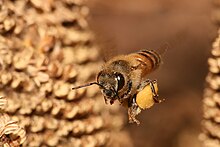 | |
| European honey bee carrying pollen back to hive | |
| Scientific classification | |
| Kingdom: | Animalia |
| Phylum: | Arthropoda |
| Class: | Insecta |
| Order: | Hymenoptera |
| Family: | Apidae |
| Subfamily: | Apinae |
| Tribe: | Apini Latreille, 1802 |
| Genus: | Apis Linnaeus, 1758 |
| Species | |
| |
Contents |
Origin, systematics and distribution
Honey bees as a group appear to have their centre of origin in South and South East Asia (including the Philippines), as all but one of the extant species are native to that region, notably the most plesiomorphic living species (Apis florea and A. andreniformis).[2] The first Apis bees appear in the fossil record at the Eocene–Oligocene boundary, in European deposits. The origin of these prehistoric honey bees does not necessarily indicate that Europe is where the genus originated, only that it occurred there at that time. There are few known fossil deposits in the suspected region of honey bee origin, and fewer still have been thoroughly studied. There is only one fossil species documented from the New World, Apis nearctica, known from a single 14-million-year old specimen from Nevada.[3]
Morphology of a female honey bee
Most species have historically been cultured or at least exploited for honey and beeswax by humans indigenous to their native ranges. Only two of these species have been truly domesticated, one (Apis mellifera) at least since the time of the building of the Egyptian pyramids, and only that species has been moved extensively beyond its native range.
Today's honey bees constitute three clades:[1][4]
Micrapis
Apis florea and Apis andreniformis are small honey bees of southern and southeastern Asia. They make very small, exposed nests in trees and shrubs. Their stings are often incapable of penetrating human skin, so the hive and swarms can be handled with minimal protection. They occur largely sympatrically though they are very distinct evolutionarily and are probably the result of allopatric speciation, their distribution later converging. Given that A. florea is more widely distributed and A. andreniformis is considerably more aggressive, honey is - if at all - usually harvested from the former only. They are the most ancient extant lineage of honey bees, maybe diverging in the Bartonian (some 40 mya or slightly later) from the other lineages, but among themselves do not seem to have diverged a long time before the Neogene.[4]Megapis
There is one recognised species in subgenus Megapis. It usually builds single or a few exposed combs on high tree limbs, on cliffs, and sometimes on buildings. They can be very fierce. Periodically robbed of their honey by human "honey hunters", colonies are easily capable of stinging a human being to death when provoked.- Apis dorsata, the giant honey bee, is native and widespread across most of South and Southeast Asia.
- Apis dorsata binghami, the Indonesian honey bee, is classified as the Indonesian subspecies of the giant honey bee or a distinct species; in the latter case, A. d. breviligula and/or other lineages would probably also have to be considered species.[5]

Apis dorsata on comb
- Apis dorsata laboriosa, the Himalayan honey bee, was initially described as a distinct species. Later, it was included in A. dorsata as a subspecies[1] based on the biological species concept, though authors applying a genetic species concept have suggested it should be considered a species.[4] Essentially restricted to the Himalayas, it differs little from the giant honey bee in appearance, but has extensive behavioral adaptations which enable it to nest in the open at high altitudes despite low ambient temperatures. It is the largest living honey bee.
Apis
- Eastern species
- European (Western, Common) honey bee

European honey bee originated from eastern Africa. This bee pictured in Tanzania.
Main article: Apis mellifera
Apis mellifera, the most commonly domesticated species, was the third insect to have its genome mapped. It seems to have originated in eastern tropical Africa and spread from there to Northern Europe and eastwards into Asia to the Tien Shan range. It is variously called the European, Western or common honey bee in different parts of the world. There are many subspecies that have adapted to the local geographic and climatic environment, and in addition, hybrid strains such as the Buckfast bee have been bred. Behavior, color and anatomy can be quite different from one subspecies or even strain to another.Regarding phylogeny, this is the most enigmatic honey bee species. It seems to have diverged from its Eastern relatives only during the Late Miocene. This would fit the hypothesis that the ancestral stock of cave-nesting honey bees was separated into the Western group of E Africa and the Eastern group of tropical Asia by desertification in the Middle East and adjacent regions, which caused declines of foodplants and trees which provided nest sites, eventually causing gene flow to cease. The diversity of subspecies is probably the product of a (largely) Early Pleistocene radiation aided by climate and habitat changes during the last ice age. That the Western honey bee has been intensively managed by humans since many millennia - including hybridization and introductions – has apparently increased the speed of its evolution and confounded the DNA sequence data to a point where little of substance can be said about the exact relationships of many A. mellifera subspecies.[4]
There are no honey bees native to the Americas. In 1622, European colonists brought the dark bee (A. m. mellifera) to the Americas, followed later by Italian bees (A. m. ligustica) and others. Many of the crops that depend on honey bees for pollination have also been imported since colonial times. Escaped swarms (known as "wild" bees, but actually feral) spread rapidly as far as the Great Plains, usually preceding the colonists. Honey bees did not naturally cross the Rocky Mountains; they were carried by ship to California in the early 1850s.
Africanized bee
Main article: Africanized bee
Widely known as the "killer bee", Africanised bees are hybrids between European stock and one of the African subspecies A. m. scutellata; they are often more aggressive than European bees but are more resistant to disease and are better foragers but do not create as much of a surplus as European bees[citation needed]. Originating by accident in Brazil, they have spread to North America and constitute a pest in some regions. However, these strains do not overwinter well, and so are not often found in the colder, more Northern parts of North America. On the other hand, the original breeding experiment for which the African bees were brought to Brazil in the first place has continued (though not as intended): novel hybrid strains of domestic and re-domesticated Africanised bees combine high resilience to tropical conditions and good yields, and are popular among beekeepers in Brazil.Beekeeping
Main article: Beekeeping
Two species of honey bee, A. mellifera and A. cerana, are often maintained, fed, and transported by beekeepers. Modern hives also enable beekeepers to transport bees, moving from field to field as the crop needs pollinating and allowing the beekeeper to charge for the pollination services they provide, revising the historical role of the self-employed beekeeper, and favoring large-scale commercial operations.Colony collapse
Main article: Colony collapse disorder
Beekeepers in Western countries have been reporting slow declines of stocks for many years, apparently due to impaired protein production, changes in agricultural practice, or unpredictable weather. In early 2007, abnormally high die-offs (30-70% of hives) of European honey bee colonies occurred in the U.S. and Québec; such a decline seems unprecedented in recent history. This has been dubbed "Colony collapse disorder" (CCD); it is unclear whether this is simply an accelerated phase of the general decline due to stochastically more adverse conditions in 2006, or a novel phenomenon. Research has so far failed to determine what causes it, but the weight of evidence is tentatively leaning towards CCD being a syndrome rather than a disease as it seems to be caused by a combination of various contributing factors rather than a single pathogen or poison, though the Israel acute paralysis virus has recently emerged as a significant candidate.[6]Recent research (2009) has found that an indicator for an impaired protein production is common among all bees affected by CCD. It is conjectured that Dicistroviridae like the IAPV may influence the genetic material of the ribosomes, which are responsible for protein production of cells.[7][8]
Life cycle

A queen bee: a yellow dot is added to assist the beekeeper in identifying the queen.
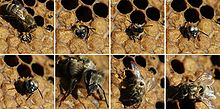
Emergence of a black bee (Apis mellifera mellifera)
Eggs are laid singly in a cell in a wax honeycomb, produced and shaped by the worker bees. Using her spermatheca, the queen actually can choose to fertilize the egg she is laying, usually depending on what cell she is laying in. Drones develop from unfertilised eggs and are haploid, while females (Queens and worker bees) develop from fertilised eggs and are diploid. Larvae are initially fed with royal jelly produced by worker bees, later switching to honey and pollen. The exception is a larva fed solely on royal jelly, which will develop into a queen bee. The larva undergoes several moltings before spinning a cocoon within the cell, and pupating.
Young worker bees clean the hive and feed the larvae. When their royal jelly producing glands begin to atrophy, they begin building comb cells. They progress to other within-colony tasks as they become older, such as receiving nectar and pollen from foragers, and guarding the hive. Later still, a worker takes her first orientation flights and finally leaves the hive and typically spends the remainder of her life as a forager.
Worker bees cooperate to find food and use a pattern of "dancing" (known as the bee dance or waggle dance) to communicate information regarding resources with each other; this dance varies from species to species, but all living species of Apis exhibit some form of the behavior. If the resources are very close to the hive, they may also exhibit a less specific dance commonly known as the "Round Dance".
Honey bees also perform tremble dances which recruit receiver bees to collect nectar from returning foragers.
Virgin queens go on mating flights away from their home colony, and mate with multiple drones before returning. The drones die in the act of mating.
Colonies are established not by solitary queens, as in most bees, but by groups known as "swarms", which consist of a mated queen and a large contingent of worker bees. This group moves en masse to a nest site that has been scouted by worker bees beforehand. Once they arrive, they immediately construct a new wax comb and begin to raise new worker brood. This type of nest founding is not seen in any other living bee genus, though there are several groups of Vespid wasps which also found new nests via swarming (sometimes including multiple queens). Also, stingless bees will start new nests with large numbers of worker bees, but the nest is constructed before a queen is escorted to the site, and this worker force is not a true "swarm".
Honey bees sense magnetic fields and use that to navigate.
Winter survival
In cold climates honeybees stop flying when the temperature drops below about 50 degrees F and crowd into the central area of the hive to form a "winter cluster." The worker bees huddle around the queen bee at the center of the cluster, shivering in order to keep the center between 80 F at the start of winter (during the broodless period) and 93 F once the queen resumes laying. The worker bees rotate through the cluster from the outside to the inside so that no bee gets too cold. The outside edges of the cluster stay at about 46-48 degrees. The colder the weather is outside, the more compact the cluster becomes. During winter, they consume their stored honey to produce body heat. The amount of honey consumed during the winter is a function of winter length and severity but ranges in temperate climates from 30 to 100 lbs.[10]Pollination
Main articles: Pollination management and List of crop plants pollinated by bees
Species of Apis are generalist floral visitors, and will pollinate a large variety of plants, but by no means all plants. Of all the honey bee species, only Apis mellifera has been used extensively for commercial pollination of crops and other plants. The value of these pollination services is commonly measured in the billions of dollars.Honey
Main article: Honey
Honey is the complex substance made when the nectar and sweet deposits from plants and trees are gathered, modified and stored in the honeycomb by honey bees as a food source for the colony. All living species of Apis have had their honey gathered by indigenous peoples for consumption, though for commercial purposes only Apis mellifera and Apis cerana have been exploited to any degree. Honey is sometimes also gathered by humans from the nests of various stingless bees.Beeswax
Main article: Beeswax
Worker bees of a certain age will secrete beeswax from a series of glands on their abdomens. They use the wax to form the walls and caps of the comb. As with honey, beeswax is gathered for various purposes.Pollen
Main article: Pollen
Bees collect pollen in the pollen basket and carry it back to the hive. In the hive, pollen is used as a protein source necessary during brood-rearing. In certain environments, excess pollen can be collected from the hives of A. mellifera and A. cerana. It is often eaten as a health supplement.Propolis
Main article: Propolis
Propolis (or bee glue) is created from resins, balsams and tree saps. Those species of honey bees which nest in tree cavities use propolis to seal cracks in the hive. Dwarf honey bees use propolis to defend against ants by coating the branch from which their nest is suspended to create a sticky moat. Propolis is consumed by humans as a health supplement in various ways and also used in some cosmetics.Defense
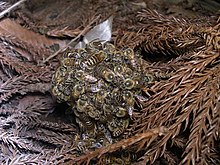
Apis cerana japonica forming a ball around two hornets. The body heat trapped by the ball will overheat and kill the hornets.
It is presumed that this complex apparatus, including the barbs on the sting, evolved specifically in response to predation by vertebrates, as the barbs do not usually function (and the sting apparatus does not detach) unless the sting is embedded in fleshy tissue. While the sting can also penetrate the flexible exoskeletal joints in appendages of other insects (and is used in fights between queens), in the case of Apis cerana defense against other insects such as predatory wasps is usually performed by surrounding the intruder with a mass of defending worker bees, who vibrate their muscles so vigorously that it raises the temperature of the intruder to a lethal level.[11] It was previously thought that the heat alone was responsible for killing intruding wasps, but recent experiments have demonstrated that it is the increased temperature in combination with increased carbon dioxide levels within the ball that produces the lethal effect.[12][13] This phenomenon is also used to kill a queen perceived as intruding or defective, an action known to beekeepers as balling the queen, named for the ball of bees formed.
Communication
Main article: Bee learning and communication
Honey bees are known to communicate through many different chemicals and odours, as is common in insects, but also using specific behaviours that convey information about the quality and type of resources in the environment, and where these resources are located. The details of the signalling being used vary from species to species; for example, the two smallest species, Apis andreniformis and Apis florea, dance on the upper surface of the comb, which is horizontal (not vertical, as in other species), and worker bees orient the dance in the actual compass direction of the resource to which they are recruiting.Symbolism
Main article: Bee (mythology)
Both the Atharva Veda[14] and the ancient Greeks associated lips anointed with honey with the gift of eloquence and even of prescience. The priestess at Delphi was the "Delphic Bee".A community of honey bees has often been employed throughout history by political theorists as a model of human society:
"This image occurs in Aristotle and Plato; in Virgil[15] and Seneca; in Erasmus and Shakespeare; in Marx and Tolstoy."[16]Honey bees, signifying immortality and resurrection, were royal emblems of the Merovingians, revived by Napoleon.[17] The bee is the heraldic emblem too of the Barberini.

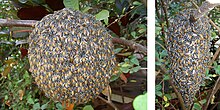






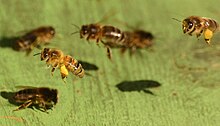


No comments:
Post a Comment